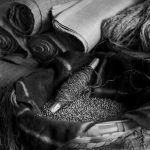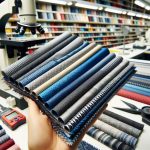Are you tired of buying jeans that don’t last? Look no further!
In this article, we will reveal five proven tests to help you determine the durability of denim fabric.
With these tests, you can ensure that your jeans will stand the test of time.
From the tensile strength test to the tear strength test, we’ve got you covered.
Say goodbye to flimsy denim and hello to jeans that will withstand anything you put them through.
Table of Contents
Tensile Strength Test
To assess the durability of denim fabric, you can conduct a tensile strength test. This test measures the maximum amount of force that the fabric can withstand before breaking or tearing. It’s a widely used method in fabric testing standards to evaluate the strength and quality of denim.
The tensile strength test involves applying a pulling force to a fabric sample until it reaches its breaking point. The force is applied in a controlled manner using a testing machine, and the results are recorded in terms of pounds or kilograms of force. By analyzing the data, you can determine the fabric’s ability to resist stretching, tearing, or breaking under tension.
The results of the tensile strength test can provide valuable insights into the durability of denim fabric and help manufacturers ensure that their products meet quality standards. Higher tensile strength indicates a more durable fabric that can withstand daily wear and tear. This test is especially important for denim, as it’s a popular choice for garments that need to be strong and long-lasting.
Abrasion Resistance Test
You can assess the durability of denim fabric by conducting an abrasion resistance test using a testing machine. This test measures how well the fabric withstands rubbing and scraping against a rough surface. The results of this test provide valuable insights into the fabric’s ability to withstand wear and tear over time.
During the abrasion resistance test, the denim fabric is subjected to repeated rubbing motions using a testing machine. The machine applies a controlled amount of pressure and friction to simulate the conditions that the fabric may experience during regular use. The number of rubs required to cause visible damage or wear on the fabric is recorded.
By conducting an abrasion resistance test, you can determine the fabric’s ability to resist pilling, fraying, and thinning. This information is crucial in assessing the fabric’s lifespan and its suitability for specific applications. For example, denim fabrics with higher abrasion resistance are more likely to last longer and withstand the rigors of daily wear, making them ideal for jeans and other clothing items that require durability.
Color Fastness Test
Continuing the assessment of denim fabric durability, an important test to consider is the color fastness test. This test evaluates how well the color of the fabric holds up over time and with repeated washing. Here are some key points to know about the color fastness test:
-
Effect of washing on color fastness: Denim fabrics are often subjected to washing, which can cause the color to fade. The color fastness test helps determine how resistant the fabric is to color loss during washing.
-
Impact of different dyeing techniques on color fastness: Different dyeing techniques can affect the color fastness of denim fabric. For example, fabrics that have been dyed using natural dyes may have a lower color fastness compared to those dyed with synthetic dyes.
-
Importance of color fastness: Color fastness is important because it ensures that the fabric retains its color and appearance even after multiple washes. This is especially crucial for denim garments, as fading color can significantly affect their overall look and appeal.
-
Testing methods: Color fastness is typically assessed using standardized testing methods such as the AATCC Colorfastness to Washing test or the ISO 105-C06 test. These tests involve subjecting the fabric to repeated washing and evaluating the color change.
-
Ratings: The results of the color fastness test are usually given in terms of a rating scale, with higher ratings indicating better color fastness. This allows manufacturers to compare and select fabrics with superior color retention properties.
Pilling Resistance Test
The pilling resistance test assesses the ability of denim fabric to resist the formation of pills, which are small balls of tangled fibers that can form on the surface of the fabric over time and with wear. Pilling is a common issue with many fabrics, including denim, and can make garments look worn out and old before their time. To prevent pilling, fabric manufacturers employ various techniques such as using longer staple fibers, adding anti-pilling agents, and employing different spinning techniques.
The importance of pilling resistance in denim garments cannot be overstated. Denim is a popular fabric choice for its durability and longevity, and pilling can greatly diminish these qualities. Denim garments, such as jeans, are often subjected to frequent and rigorous use, including washing and drying. Without proper pilling resistance, the fabric can quickly become unsightly and uncomfortable to wear.
To better understand the pilling resistance of denim fabrics, manufacturers conduct pilling resistance tests. These tests involve subjecting the fabric to rubbing or abrasion, simulating the friction that occurs during normal wear. The degree of pilling is then assessed using a rating scale, with higher ratings indicating better resistance to pilling.
The table below showcases the pilling resistance ratings typically used in these tests:
| Pilling Resistance Rating | Description |
|---|---|
| 1 | No pilling |
| 2 | Slight |
| 3 | Moderate |
| 4 | Severe |
| 5 | Very severe |
Tear Strength Test
To assess the tear strength of denim fabric, perform a tear strength test. This test is crucial in determining the fabric quality and fabric durability.
Here are five key points about the tear strength test:
-
Objective: The tear strength test measures the force required to tear the fabric apart. It helps evaluate how well the fabric can withstand tearing forces, indicating its durability.
-
Procedure: The test involves cutting a sample of the denim fabric, creating a small slit in the middle, and securing the fabric ends to a machine. The machine then applies a controlled force to tear the fabric apart.
-
Measurement: The tear strength is measured in pounds or Newtons. A higher tear strength value indicates a stronger fabric with better resistance to tearing.
-
Factors affecting tear strength: Various factors can influence tear strength, such as the fabric’s weave, thread count, and fiber type. Additionally, fabric treatments, finishes, and overall construction play a role in determining tear resistance.
-
Importance: Assessing tear strength is crucial in determining the fabric’s ability to withstand daily wear and tear. Fabrics with higher tear strength are more likely to last longer, ensuring better fabric durability.
Frequently Asked Questions
How Can Denim Fabric Durability Be Affected by Washing and Drying Methods?
Different washing temperatures can affect the durability of denim fabric. Using high temperatures can weaken the fabric, while cold water preserves it. Similarly, different drying methods impact durability. Air drying is gentler than machine drying.
Is There a Specific Weight Range That Indicates Higher Durability in Denim Fabric?
There isn’t a specific weight range that indicates higher durability in denim fabric. The relationship between weight and durability can vary due to other factors like the type of weave and fabric construction.
Can the Durability of Denim Fabric Be Influenced by the Type of Dye Used in the Manufacturing Process?
The type of dye used in the manufacturing process can influence the durability of denim fabric. Different dyeing methods can have an impact on the strength of the fabric.
Are There Any Specific Care Instructions That Can Help Prolong the Durability of Denim Fabric?
To prolong the durability of your denim fabric, follow specific care instructions. Avoid using harsh detergents or bleach, and wash on a gentle cycle. Hang dry or use a low heat setting when drying to prevent damage.
Does the Thread Count of Denim Fabric Have Any Impact on Its Overall Durability?
The thread count of denim fabric can impact its overall durability. The construction of the fabric, including the number of threads woven together, affects how well it can withstand wear and tear.
- Why Open-Weave Scrim Is the Secret to Stunning Event and Canopy Designs - June 26, 2025
- Creating Large-Scale Art Installations With Scrim Fabric - June 26, 2025
- Scrim Fabric in Upholstery: Understanding Its Use as a Backing Material - June 26, 2025






